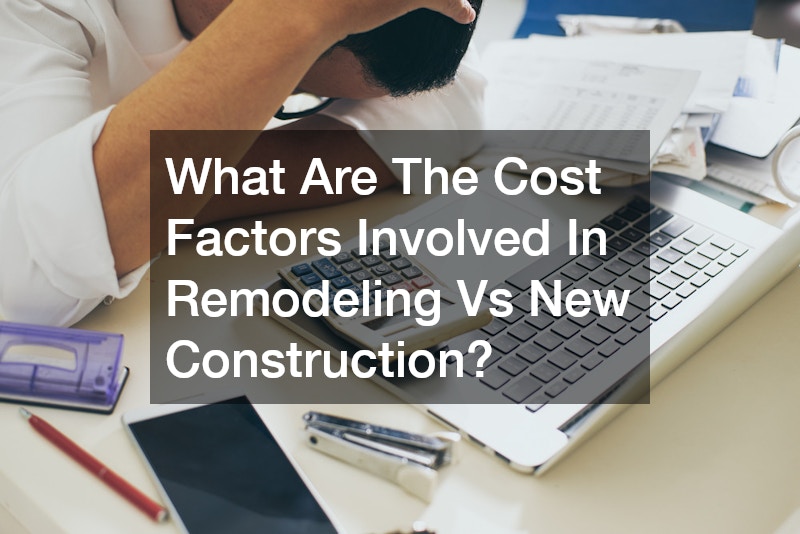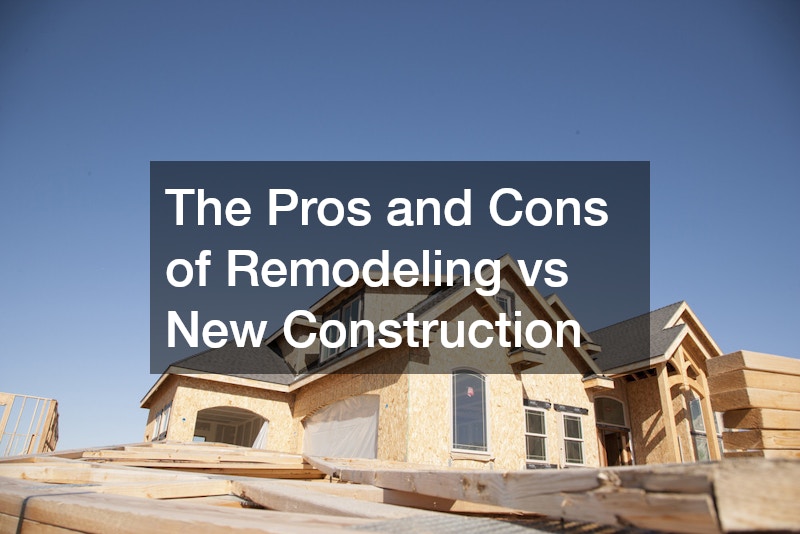Deciding whether to remodel an existing home or build a new one is one of the most significant choices a homeowner can face. This decision involves more than just personal preference; it encompasses budgetary constraints, space requirements, environmental considerations, and long-term resale value. Factors such as local building regulations, contractor availability, and the scope of desired changes all influence this choice. Services such as residential roofing, siding company consultations, and fence contractor guidance often play a supporting role in ensuring a successful project.
How To Decide Between Remodeling And New Construction?
Choosing between remodeling and new construction begins with careful evaluation of needs and resources. Each homeowner’s situation is unique, and understanding the factors that influence the decision is essential. Key considerations include budget, space requirements, timeframe, future resale value, and compliance with local building codes.
Assessing Budgetary Constraints
Budget is one of the most critical factors in this decision. Remodeling may seem more affordable initially, but unforeseen costs can accumulate, especially when dealing with older structures. Unexpected structural issues, outdated wiring, or plumbing can add significant expenses. Conversely, new roof installation and shingle roofing in a new build may appear expensive upfront but often reduce maintenance costs in the long term. Homeowners must account for labor, materials, and specialized services such as crane rental for larger additions or structural changes.
Evaluating Space And Location Needs
The size of your current property and its location can dictate the feasibility of remodeling. If your home is on a constrained lot, expansion may be limited, making new construction a more practical solution. Conversely, remodeling can optimise the existing footprint, adding functionality through interior reconfigurations or extensions, supported by services like vinyl fence installations to enhance outdoor space.
Considering Timeframe And Urgency
Time constraints play a critical role. Remodeling projects may be quicker if changes are minor, but extensive renovations can extend longer than expected due to unforeseen complications. New construction allows for a structured timeline with clearly defined milestones, often requiring resources like roll off containers for debris management during the building process.
Reviewing Future Resale Value
The potential return on investment must also be evaluated. Remodeling can increase a home’s resale value, particularly if upgrades align with market trends, such as modernized roofing services or updated siding. New construction, however, may offer higher resale value due to its custom design, modern amenities, and energy-efficient systems.
Understanding Local Building Regulations
Compliance with local building codes and zoning laws is essential. Remodeling might be restricted by structural limitations or historical preservation rules, while new construction requires full adherence to current building standards. Engaging a siding company or experienced contractor ensures all legal requirements are met.
What Are The Cost Factors Involved In Remodeling Vs New Construction?

Financial planning is a critical step in deciding between remodeling and new construction. Costs can vary widely depending on project scope, materials, and labor.
Labor Costs And Contractor Fees
Labor costs often make up a significant portion of expenses. Remodeling existing structures may involve specialized tradespeople for residential roofing, siding repairs, or vinyl fence installation. New construction requires coordination among multiple contractors and may include services like crane rental for heavy lifting, which can increase overall costs.
Material Costs Comparison
Material quality directly impacts both remodeling and new construction budgets. High-quality shingle roofing or durable siding materials may increase upfront costs but reduce maintenance in the long run.
Permits And Inspection Costs
Both remodeling and new construction involve permitting and inspection fees. Larger projects, such as structural additions or new roof installation, may require multiple inspections. Working with a knowledgeable contractor or fence contractor can help navigate these regulatory requirements efficiently.
Long-term Maintenance Expenses
Maintenance considerations should not be overlooked. Older homes may require ongoing repairs, such as siding replacements or roof repairs, whereas new construction often incorporates low-maintenance materials and modern systems that reduce long-term expenses.
Potential Unexpected Expenses
Unexpected costs can arise in both scenarios. Remodeling may uncover hidden damage like water infiltration or termite infestations, while new construction may face delays due to weather or supply chain issues. Planning for contingencies, including roll-off containers for debris and removal, is essential to avoid budget overruns.
What Is The Timeline For Remodeling Vs New Construction?
Time management is a significant factor when weighing the two options. Understanding potential timelines helps homeowners set realistic expectations.
Estimating Project Duration
Remodeling timelines vary depending on the extent of the work. Small-scale updates can take weeks, while major renovations may extend over several months. New construction typically follows a structured schedule from groundbreaking to final inspection, with clear milestones.
Planning And Design Phase Duration
Both options require careful planning. Remodeling may involve redesigning spaces to accommodate residential roofing upgrades or siding company consultations, while new construction necessitates architectural designs and site preparation. Both processes require detailed coordination with contractors and designers.
Understanding Delays And Setbacks
Delays can arise from material shortages, weather conditions, or contractor availability. Using resources like roll-off containers ensures that waste management does not impede progress, keeping the project on track despite setbacks.
Environmental And Weather Impacts
Weather conditions can significantly affect timelines, particularly for exterior projects like new roof installation or shingle roofing. Homeowners must account for seasonal variations and environmental challenges when scheduling their project.
Importance Of A Reliable Schedule
A well-defined schedule ensures efficiency and reduces stress. Contractors can coordinate multiple teams effectively, including local tree removals or vinyl fence installation, to avoid overlapping work and delays.
Are There Environmental Considerations To Keep In Mind?

Environmental impact is increasingly important in construction decisions. Both remodeling and new construction can adopt eco-friendly practices to reduce their footprint.
Assessing The Environmental Footprint
Remodeling can minimize environmental impact by reusing existing materials. New construction, however, often requires more raw materials and generates additional waste, which can be managed with roll off containers for proper disposal.
Sustainable Material Options
Choosing sustainable materials, such as energy-efficient shingle roofing or recycled siding, reduces environmental impact. Homeowners may consult a siding company or roofing specialist to source eco-friendly options that align with project goals.
Energy Efficiency Improvements
Both approaches offer opportunities to enhance energy efficiency. New construction allows for modern insulation, smart HVAC systems, and residential roofing designed for optimal thermal performance. Remodeling can also integrate upgrades to improve energy usage and reduce utility costs.
Waste And Recycling Concerns
Construction generates significant waste. Using roll-off containers facilitates proper recycling and disposal, whether the project involves remodeling an existing home or building a new structure. Careful planning ensures minimal environmental disruption.
Long-term Environmental Impact
Long-term considerations include energy efficiency, durability of materials, and landscape preservation. Strategic use of contractors for local tree removals or vinyl fence placement ensures minimal disruption to the surrounding environment while maintaining functional outdoor spaces.
How Does Remodeling Affect The Value Of A Home Compared To New Construction?
Understanding how each option impacts property value is crucial for long-term planning.
Impact On Home Resale Value
Remodeling can enhance resale value by modernizing spaces and improving aesthetics, particularly through services like residential roofing upgrades or updated siding. New construction often yields higher market value due to modern layouts and materials.
Immediate Return On Investment
Investments in remodeling or new construction can vary in ROI. Upgrading features such as shingle roofing or vinyl fence installations may offer quicker returns, while new construction may provide a higher overall value over time.
Market Trends And Preferences
Market preferences shift toward modern, energy-efficient homes with updated amenities. New construction easily integrates these trends, while remodeling may require careful balancing of existing features with contemporary updates.
Customization Vs Standardization
Remodeling allows customization within the constraints of the current structure. New construction offers complete freedom to incorporate desired features such as integrated residential roofing, advanced siding, or smart layouts.
Effect Of Modernization
Modernizing older homes through remodeling can enhance appeal, particularly with roofing services and exterior updates. New construction inherently meets modern standards, offering turnkey solutions that appeal to buyers seeking contemporary living.
What Are The Emotional Factors In Remodeling Vs New Construction?
The emotional aspect of construction decisions often influences homeowner satisfaction and stress levels.
Attachment To Current Home
Homeowners may feel a strong connection to their current home, making remodeling an emotionally comforting choice. Preserving familiar spaces while updating essentials can create a blend of nostalgia and modern convenience.
Stress Of Construction Process
Construction can be stressful regardless of the approach. Coordinating contractors, managing timelines, and addressing unexpected issues like local tree removals or debris management with roll off containers requires patience and organization.
Satisfaction With Customization
Both remodeling and new construction provide opportunities for personalization. Remodels allow incremental changes, while new construction offers a clean slate for designing custom features such as vinyl fence layouts or modern siding company solutions.
Fear Of The Unknown
Uncertainty about costs, structural issues, or regulatory approvals can create anxiety. Consulting experienced contractors for residential roofing or new roof installation helps mitigate these concerns and provides clarity.
Impact On Family Dynamics
Construction can disrupt daily life. Families must plan for temporary adjustments during both remodeling and new construction, ensuring safety and minimizing inconvenience.
Should I Consider Remodeling To Customize My Home?

Remodeling offers opportunities to adapt existing spaces while retaining the core structure of the home.
Flexibility In Design Choices
Remodeling allows homeowners to introduce new features, such as updated shingle roofing, modern siding, or vinyl fence additions, without starting from scratch. This flexibility helps maintain the home’s character while meeting current needs.
Limitations Of Structural Changes
Structural limitations may restrict extensive renovations. Services like crane rental may enable certain expansions but require careful planning and additional costs.
Importance Of Professional Guidance
Engaging professionals ensures remodeling meets safety and quality standards. Roofing services, siding company consultations, and certified fence contractors provide expertise crucial for a successful project.
Balancing Style With Practicality
Homeowners must weigh aesthetic desires against structural feasibility and budget. Strategic upgrades, such as energy-efficient residential roofing or practical roll off containers management, ensure a balanced outcome.
Historical Home Considerations
Older homes may have historical value, influencing renovation decisions. Sensitive remodeling preserves charm while incorporating modern necessities like new roof installation or updated siding.
Is New Construction A Better Option For Modern Amenities?
New construction often excels in providing state-of-the-art features tailored to contemporary lifestyles.
Availability Of Modern Systems
Modern construction accommodates updated mechanical, electrical, and plumbing systems seamlessly. Features such as advanced residential roofing, integrated siding, and efficient layouts optimize comfort and functionality.
Smart Home Integration
New homes are designed with technology integration in mind. Smart systems for lighting, climate control, and security can be incorporated during construction, ensuring seamless functionality without retrofitting.
Adaptability For Future Technologies
Building new allows for future-proofing infrastructure, accommodating upgrades without the limitations of existing structures. This includes planning for advanced roofing services or smart fencing options.
Energy Management Systems
Modern energy solutions, including solar-ready shingle roofing and efficient insulation, reduce long-term costs and environmental impact, highlighting the advantages of new construction.
Meeting Contemporary Lifestyle Needs
New homes cater to modern living requirements, from open-concept spaces to integrated outdoor features. Collaboration with fence contractors, siding companies, and residential roofing experts ensures a cohesive, functional design.
What Are Common Challenges Faced In Remodeling Vs New Construction?
Both approaches present unique challenges requiring careful planning and experienced oversight.
Overcoming Design Challenges
Design limitations may arise in remodeling due to structural constraints. New construction allows full creative freedom but requires careful coordination to realize the vision effectively.
Navigating Construction Permits
Securing permits can be complex. Experienced contractors guide homeowners through regulatory requirements, whether managing roll off containers for demolition or coordinating residential roofing installation.
Budget Overruns
Unexpected expenses are common in both approaches. Proactive planning, including consulting professionals for new roof installation or vinyl fence installations, helps mitigate financial risks.
Managing Contractor Relationships
Strong communication with contractors is essential. Skilled professionals, including siding companies and fence contractors, ensure the project runs smoothly and meets expectations.
Dealing With Unexpected Issues
Construction projects often encounter unforeseen problems. Preparing for contingencies, such as weather delays or local tree removals, ensures minimal disruption and keeps the project on track.
How To Choose The Right Professionals For Remodeling Or New Construction?

Selecting the right team of professionals is crucial for success, whether remodeling or building anew.
Finding Qualified Contractors
Researching and hiring qualified professionals, including residential roofing experts, siding companies, and fence contractors, ensures quality workmanship and adherence to safety standards.
Role Of Architects And Designers
Architects and designers translate visions into actionable plans. Collaboration with these professionals guarantees that remodeling or new construction achieves both aesthetic appeal and functional efficiency.
Legal And Insurance Considerations
Proper legal documentation and insurance coverage protect homeowners and contractors from potential disputes, particularly for large-scale work like residential roofing or roll off containers management.
Building A Collaborative Team
Successful projects rely on teamwork among contractors, designers, and homeowners. Integrating siding companies, fence contractors, and local tree removals specialists ensures comprehensive project management.
Deciding between remodeling and new construction is complex, requiring evaluation of budget, timeline, environmental impact, and personal preferences. Remodeling preserves the familiarity of an existing home while allowing targeted upgrades such as residential roofing and vinyl fence enhancements. New construction provides freedom to design modern, energy-efficient spaces incorporating new roof installation, smart systems, and contemporary layouts. By carefully considering financial, practical, and emotional factors and working with skilled professionals, homeowners can make a choice that maximizes satisfaction and long-term value.


